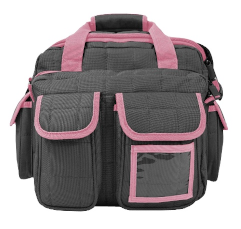What’s in Your Range Bag?
One question I often get asked is, “What’s in your range bag?” I have to say, “It depends.” I have many reasons to go to the range; to teach, to shoot with friends, and to practice practical shooting drills. I have several range bags and choose what I take based on the reason I’m there.

First, let’s consider your range bag. If you are new to shooting and money is an issue then using a gym bag will work. The advantage of range-specific bags is that they have lots of pockets for safety equipment, ammunition and other things. There are many styles of range bags to choose from. You can find small range bags for around $30, a backpack style bag like the G. P. S. Tactical range bag for around $150; or a bag with a telescopic handle and wheels, like the Gun Tote’n Mamas rolling range bag for about $280. You want to make sure the bag will hold safety equipment, range gear, at least one handgun in a soft or hard plastic case, and ammunition.
If you are a new shooter, I highly recommend you have what I call the basics, your safety equipment: eyes and ears. If you are shooting at an indoor range and you don’t wear prescription impact resistant glasses, then invest in a good pair of clear safety glasses. If you are at an outdoor range and you wear sunglasses double check that they are impact resistant, as most are. For ear protection, I suggest stereo earmuffs to start. These are earmuffs that go over your head and cover your ears with padded muffs, protecting them from the sound of the shots while allowing you to hear other people when they are speaking. This is a must when you are with other people at the range or taking a class. Walker’s Razor compact style is a good starting pair for under $60. What’s beyond the basics? I have a few more suggestions.
I always pack hats with brims, like a baseball cap, to keep flying brass from hitting you in the face, and a bandana to cover your neck if you wear a collar lower than a tee shirt. If you shoot, then you have probably been hit by hot, flying brass and it isn’t fun. You can end up with small burn marks and if you are new shooter it could be dangerous if you flinch or move your muzzle in an unsafe direction.
Other things I have in my range bags are a basic gun cleaning kit, rags, small screw drivers in flat and Phillips head, and a pocket knife. You may need to do a quick cleaning on the range or tighten up a sight or holster screw, you never know. Sometimes I’m at a range where I have to bring my own targets. I like to shoot at paper plates, they are cheap and easy to attach to target stands. Duct tape and a staple gun with extra staples are also in my bag. Speaking of staple gun, I’ve been known to get a staple in my palm, so I highly recommend a basic first aid kit with bandaids, antiseptic wipes and Neosporin.
The most important things to pack in your range bag are your firearm and ammunition! I suggest a soft gun sock or a hard plastic gun case to keep your firearm protected from dirt, sand and loose things in your bag. Double check that your cased firearm is unloaded with the slide or cylinder open for inspection. Some ranges want to inspect your unloaded firearm prior to entrance to the range. Keep your ammunition in the boxes you purchased them in or, if you use reloads, a plastic case for reloaded ammunition. Packing several plastic grocery bags or small garbage bags in case you have to pick up spent brass or carry out your garbage like empty ammunition boxes is also a good idea.
Keeping a designated range bag with the basics packed at all times, like eye and ear protection, will make your trips to the range much easier. As you continue to shoot and attend different ranges, you’ll add to your range bag using your experience to guide you. You may even end up with a 20 gallon plastic tote packed for the range, in addition to your bag, like I have, but that's another article!
